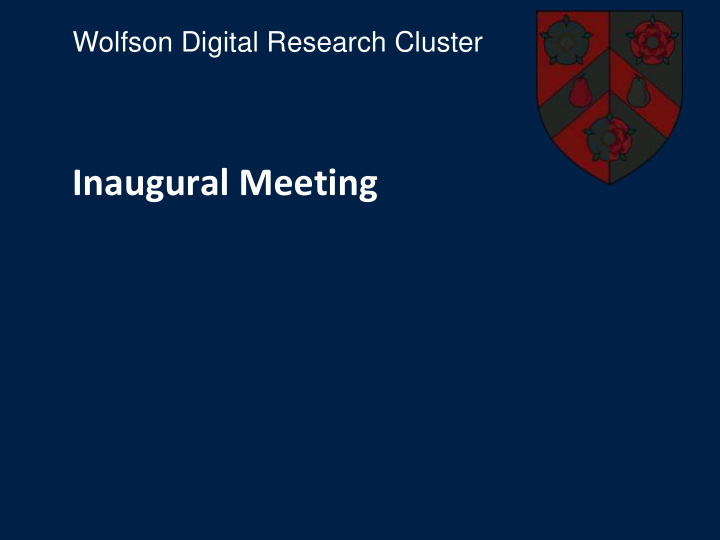



Wolfson Digital Research Cluster Inaugural Meeting
Wolfson Digital Research Cluster What could a Digital Research Cluster do for the College? Donna Kurtz Professor of Classical Art and Beazley Archivist
Why clusters? Promote interdisciplinary research Raise profile of the college Attract funds for scholarships Attract funds for DRC activities, e.g. , Workshops, Summer Schools, etc. Page 3
Why Wolfson? Graduate Large Arts and Sciences Other clusters in college: transfer of benefits Page 4
CLAROS – an example of a collaboration • Humanities • Social Sciences • MPLS • Museums and Collections • Kurtz and Shotton, GBFs • Membership across college Page 5
OeRC www.oerc.ox.ac.uk OeRC is the institutional base for CLAROS OeRC can coordinate new projects created by DRC Page 6
OII www.oii.ox.ac.uk OII could serve this role for: • Politics • Economics • e-governance Page 7
What is Digital Research? Almost any type of research Expressions of interest have come from: • Medical Sciences • Politics • Social Sciences and Law • Humanities Page 8
Wolfson Digital Research Cluster Biological data management and semantic enhancements of scholarly publishing David Shotton Reader in Image Bioinformatics
The challenges of the biological data deluge Nucleic Acids Research Database Collection 1400 Cochrane GR, Galperin MY (2010) Number of bioinformatics databases Nucleic Acids Research 38:D1-D4 1200 1000 800 600 400 200 0 2003 2004 2005 2006 2007 2008 2009 2010 Year
OpenFlyData sources: Drosophila gene expression data Page 11 FlyAtlas
Same data integrated in a single OpenFlyData window Page 12
The CLAROS Explorer classical art browse interface Page 13
Semantic enhancement of an exemplar research article Page 14
Current ‘data care’ R&D projects The ADMIRAL Project helping researchers in Zoology to to locally manage research data, then publishing selected datasets in the Oxford DataBank The Dryad-UK Project publishing biological datasets related to peer-reveiwed journal articles in the Dryad data repository The Open Citations Project publishing bibliographic citations as Linked Open Data Open Research Reports publishing structured summaries of infectious disease articles as open access mini-publications, to get round subscription barriers that block access to biomedical information in the developing world Page 15
Wolfson Digital Research Cluster Places ancient and modern Sebastian Rahtz Head of Information and Support Group, OUCS
The name Παράμονος Page 17
Mobile Oxford Page 18
William Godwin’s Diary Page 19
Protestants buried in Rome Page 20
Oxford Science Area Page 21
<person> <sex>1</sex> Underlying issues <persName> <forename>John</forename> <surname>Keats</surname> The importance of place </ </persName> The importance of time <death when="1821"/> <nationality key="UK"/> The importance of people <occupation>poet</occupation> </person> Multiple sources and types of data Some answers • Common vocabularies • Common data formats • Resources, not answers Page 22
The Metamorphoses Project aims Combine many sources of geolocation data (CLAROS, Pleiades, Yahoo, Geonames, Getty) Find points of commonality by name, location and date Model change of name and place over time Provide geolocation lookup service for Oxford Produce visualisations and mashups Use the same technologies and vocabularies as modern open data Page 23
5-star data http://www.w3.org/DesignIssues/LinkedData.html ★ Available on the web (whatever format), but with an open licence ★★ Available as machine-readable structured data (e.g. excel instead of image scan of a table) ★★★ as (2) plus non-proprietary format (e.g. CSV instead of Excel) ★★★★ All the above plus, Use open standards from W3C (RDF and SPARQL) to identify things, so that people can point at your stuff All the above, plus: Link your data to other people’s data to ★★★★★ provide context Page 24
Wolfson Digital Research Cluster A database for the Roman Economy Miko Flohr Assistant Director, Oxford Roman Economy Project
The Oxford Roman Economy Project AHRC funded first phase (2005-2010), continuing until end 2012 at least. Studying economic history of the Roman world through large, quantifiable datasets. Aims: Understanding economic geography Understanding change over time (growth and decline) Studying local phenomena to greater depth Using known (and published) archaeological and textual data Page 26
The OxREP databases, an inventory: Roman Shipwrecks Roman mines Roman villas with multiple sets of wine and olive presses (all) Roman cities A complete inventory of the Karanis Tax Rolls Land property lists Alimenta lists An inventory of machines mentioned in literature An inventory of canals in the Roman world Roman coins found in India ... and (many) more to be added in the future Page 27
What we needed A powerful, flexible database A good back-end website for updating the database A user-friendly front-end website for browsing, searching and querying the database, including: Mapping facility Chart facility Facility to store queries References to scholarly literature Page 28
Database design: what we had... ... a quantity of databases: made by different people, some of whom had already left Oxford In different file format (acces, excel) With different levels of detail, complexity and accuracy Sometimes with internal inconsistencies High reliance on text fields (and thus, inevitably, many typo’s) Different ways of referencing Page 29
Database design Areas Bibliography Keywords (tags) Sites References Structures Documents Spaces Transactions Events Objects Page 30
Page 31
Page 32
Wolfson Digital Research Cluster Web-scale music analysis, linking, and life-writing David De Roure Professor of e-Research, OeRC National Director of Digital Social Research, ESRC
Structural Digital Music Analysis of Large Collections Amounts of Music Information Community Crowdsourced Software ground truth Supercomputer Linked Data Repositories Page 34 salami.music.mcgill.ca
What's the score at the Bodleian? Page 35
www.oerc.ox.ac.uk Page 36
Wolfson Digital Research Cluster Discussion David Robey Arts and Humanities Consultant, OeRC
Recommend
More recommend